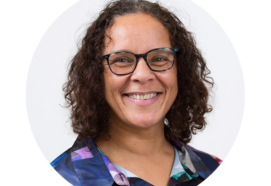In this Papers Podcast, senior researcher Dr. Britt Morthorst discusses her JCPP Advances paper ‘Internet based intervention (Emotion Regulation Individual Therapy for Adolescents) as add-on to treatment as usual versus treatment as usual for non-suicidal self-injury in adolescent outpatients: The TEENS randomised feasibility trial’ (https://doi.org/10.1002/jcv2.12115).
Britt is the first author of the paper.
There is an overview of the paper, methodology, key findings, and implications for practice.
Discussion points include;
- What is the usual treatment for adolescents presenting with non-suicidal self-injury?
- What is ‘Emotion Regulation Individual Therapy for Adolescents’, and how does it differ from treatment as usual?
- What does the Emotion Regulation Individual Therapy for Adolescents consist of?
- Will internet-based Emotion Regulation Individual Therapy for Adolescents be a valuable additional to treatment as usual for adolescents engaging with non-suicidal self-injury?
In this series, we speak to authors of papers published in one of ACAMH’s three journals. These are The Journal of Child Psychology and Psychiatry (JCPP); The Child and Adolescent Mental Health (CAMH) journal; and JCPP Advances.
Subscribe to ACAMH mental health podcasts on your preferred streaming platform. Just search for ACAMH on; SoundCloud, Spotify, CastBox, Deezer, Google Podcasts, Podcastaddict, JioSaavn, Listen notes, Radio Public, and Radio.com (not available in the EU). Plus we are on Apple Podcasts visit the link or click on the icon, or scan the QR code.

Dr. Britt Morthorst is an Associate Professor at the Department of Clinical Medicine in the Faculty of Health, at the University of Copenhagen, and a member of the Danish Research Institute for Suicide Prevention. Britt is also a Senior Researcher in Child and Adolescent Mental Health Services in the Capital Region, Denmark, with an interest in investigating self-harm and self-injury. Since 2007, Britt worked in adult psychiatry suicide prevention, and this is where great parts of her work was conducted. However, in 2018, Britt transferred to child and adolescent psychiatry and has found this work to be very meaningful.
Transcript
[00:00:01.390] Jo Carlowe: Hello, welcome to the Papers Podcast series for the Association for Child and Adolescent Mental Health, or ACAMH for short. I’m Jo Carlowe, a Freelance Journalist with a specialism in psychology. In this series we speak to authors of papers published in one of ACAMH’s three journals. These are the Journal of Child Psychology and Psychiatry, commonly known as JCPP, the Child and Adolescent Mental Health, known as CAMH, and JCPP Advances.
Today I’m interviewing Senior Researcher Dr. Britt Morthorst, Associate Professor at the Department of Clinical Medicine in the Faculty of Health at the University of Copenhagen, and a member of the Danish Research Institute for Suicide Prevention. Britt is the first author of the JCPP Advances paper “Internet-based intervention (Emotion Regulation Individual Therapy for Adolescents) as add-on treatment as usual versus treatment as usual for non-suicidal self-injury in adolescent outpatients: The TEENS randomised feasibility trial.” This paper will be the focus of today’s podcast.
If you’re a fan of our Papers Podcast series, please subscribe on your preferred streaming platform, let us know how we did, with a rating or review, and do share with friends and colleagues.
Britt, welcome, thank you for joining me. Can you start with an introduction about who you are and what you do?
[00:01:27.210] Dr. Britt Morthorst: Thank you, Jo, it’s an honour to be here talking to you. I’m a Senior Researcher in Child and Adolescent Mental Health Services in the Capital Region Denmark, and I work in a research unit with more than 50 Researchers, within different areas of expertise, and I’m the one investigating self-harm and self-injury.
So, children and adolescent currently are having difficult times and some develop self-harming behaviours, which is very painful and distressing, and within this theme, I have experiences with conducting both clinical trials and register-based trials, but I think the clinical trials are my favourite. So, the idea of providing evidence for interventions to youth in great psychic pain, that is very meaningful work.
[00:02:15.200] Jo Carlowe: Can I ask how you got into this work?
[00:02:17.330] Dr. Britt Morthorst: So, I’ve been into adult psychiatry and suicide prevention since 2007, and that is where great parts of my work was conducted, but then in 2018, I was transferred to Child and Adolescent Psychiatry. And since children and adolescents currently are, one could say, in a pretty bad shape, then it’s very meaningful for me to be down here and doing research within this area, since we see self-harming behaviour across all kind of psychopathologies within these services.
[00:02:51.489] Jo Carlowe: Thank you. The focus is your paper, this is “Internet-based intervention (Emotion Regulation Individual Therapy for Adolescents) as add-on treatment as usual versus treatment as usual for non-suicidal self-injury in adolescent outpatients: The TEENS randomised feasibility trial,” which was recently published in JCPP Advances. Britt, can you give us an overview? What did you look at and why?
[00:03:15.360] Dr. Britt Morthorst: The reason why we started this is because evidence-based treatment for specifically non-suicidal self-injury is quite sparse. So we do have evidence in favour of dialectical behavioural therapy, but this is a very extensive and resource-demanding treatment, both for the patients and for services. And it is mainly provided patients at later stages where they have repeated self-harming behaviour, where they have a low functional level, and where they may also show personality trait – disorder traits.
The idea here was for us to see if we could test an intervention at earlier stages than when self-injury or self-harming behaviour has become, like, more consistent. And since internet-based therapy has not previously been offered within Child and Adolescent Mental Health Services in the Capital Region of Denmark, then we preferred to conduct this feasibility study, in the first place, to see if it was at all doable, if the young persons found the approach meaningful, if they wanted to participate. And then, of course, we also had to test safety procedures, so that’s why we decide this feasibility study, applying a randomisation procedure, but focusing on feasibility measures as outcomes.
[00:04:35.940] Jo Carlowe: Before we go into some of the findings, I think it would be useful just to take a step back and for you to explain to us what is the usual treatment for adolescents presenting with non-suicidal self-injury?
[00:04:47.370] Dr. Britt Morthorst: The reality is that specific NSSI treatment is very sparse. So, sometimes a non-suicidal self-injury behaviour is treated as part of the main psychiatric diagnosis for which the child is treated or referred, and which means that it can – this can sometimes be cognitive behavioural therapy, it can be mentalisation. And it is provided more often for the anxiety disorder, or for the depression state, and not generally focusing on the non-suicidal behaviour. So it’s addressed like a side aspect of the, like, main disease for which they are referred, and one could also say that the shift in this intervention is on emotion regulation, and that seems very helpful.
[00:05:39.220] Jo Carlowe: Well, what is emotion regulation individual therapy for adolescents? Well – and how does it differ from treatment as usual?
[00:05:47.400] Dr. Britt Morthorst: So emotion regulation group therapy was developed for younger adults in group therapy, and for a bit the population of self-harming younger adults with repeated self-harm, where the shift is instead of focusing on the non-suicidal behaviour, the life-threatening aspect of it, or the very self-harming distress within that focus, the focus now here is on how to handle difficult emotions. And it’s shown several times and very consistently that emotion regulation is the purpose or the motivation that self-harming behaviour often serves. Which means that if we can help the self-harming patient to shift focus away from the self-harming behaviour and then towards both the recognition of difficult emotions and teach them how to regulate these emotions in a more adequate manner, then we can help them to release this need for self-harm.
I can also add that this emotion regulation therapy that we provide as internet-based treatment is inspired by elements from CBT and DBT and also ACT, and commitment therapy. So it’s – it like – it’s inspired by all these aspects that are already used in evidence-based treatment, which is in place in services for the time being, but consistently, the focus is on emotions and emotion recognition.
[00:07:28.849] Jo Carlowe: Hmmm hmm, and in this case, it’s individual rather than group.
[00:07:32.960] Dr. Britt Morthorst: Yeah, it’s individual, but the thing about the individual therapy is that non-suicidal self-injury behaviours, they may get out the risk of, like, spill over within group settings. So it’s preferably for us to have the participance of patients individually, and also, in this case, since it’s internet-based, then it is an individual programme.
So our ERITA programme consists of an introduction plus 11 modules, and these modules, they kind of – there’s text to read, there is videos to see, there’s audios to listen to, and then there are exercises. There could be drags and drops, and there would be, like, fields to – where you can insert personal details and comments and have a dialogue with your individual ERITA Therapist. It’s a personal development to follow the programme.
And in this programme, there’s also a part for the parents. This is an – six-module programme, which means that every second week, a new module will open for the parents, and they also have this opportunity to have a therapeutic dialogue within the programme with the Therapist. And it’s the same Therapist that, kind of, provide help and support for the adolescent as for the parent, but they have separate individual tracks. So they don’t have access to each other’s content, and what is shared between the Therapist and adolescent is not available for the parent, and the other way around, also. So it’s confidential, but of course, it gives the Therapist insight in family needs and dynamics.
[00:09:29.860] Jo Carlowe: Can you tell us a little more about the methodology used for this study?
[00:09:35.399] Dr. Britt Morthorst: So, since this had never been, like, provided or tried out before within mental health services for children and adolescents in Denmark, we had to see if it was doable at all, so that was our main focus. And therefore the feasibility outcomes that we focused on, that was the rate of participants fulfilling inclusion criteria and agreeing to participate, consenting to participate, which means that they were randomised, the randomisation rate, you can say, then the compliance rate.
We decided that compliance would be for the participant to follow at least six out of these 11 modules, and then, in order for us to prepare for a large-scale trial, a very important outcome also would be, how many would attend follow-up assessment. Because that is, of course, very essential to obtain data for a randomised clinical trial to see if we should detect any effect of this. So that was very essential; if a lot of the participants were not agreeing to participate in the follow-up interview, then wouldn’t be doable.
And also, in this preparation of a large-scale trial, we applied a randomisation procedure, even in the feasibility design, just also to get an impression of how the families and the adolescents reacted to the randomisation procedure.
[00:11:06.250] Jo Carlowe: Well, you obviously did something right because previous reviews that have investigated the use of digital interventions for people with non-suicidal self-injury have suggested that young people lose interest and do not complete the therapeutic intervention. That wasn’t the case with your study. I believe you saw a 90% completion, which exceeded your pre-set criteria for feasibility.
[00:11:29.750] Dr. Britt Morthorst: Hmmm.
[00:11:30.750] Jo Carlowe: What did you do right, can you elaborate?
[00:11:32.639] Dr. Britt Morthorst: Yeah, yeah, yeah, first I would like to say that in total, we included 30 participants with an – also and participating parents, so we allocated 15 to each arm. We lost two to follow-up in the experimental group, and only one in the standard group, which is, like, not very much, and they were lost, like, to, as you say, lack of interest, no harmful events. And we found that 54% of the eligible families, they agreed or consented to participate, and 87%, they fulfilled or completed more than six out of 11 modules. And, as you say, 90% talked to me at follow-up, at the blinded outcome assessment at end of treatment.
And one thing I would say was essential here, that was both the preparation when including the families, we firmly described the procedures within participating in a trial. I know all trial conductors do so, but we firmly described the process, from baseline to follow-up, for the participants. And then I think one of the very essential things, that is the Therapist guidance, which is very, very essential. I think without the alliance of the Therapist, then we would expect, as you say, participants to lose interests.
I think if you, kind of, leave youth or adolescence or – with an app for themself to navigate, then I think it’s totally different from what we did and how we provided it, because we ha – we were in close contact, though it was in writing with the participants on an individual level and providing support for their individual needs.
And then another aspect, Jo, about internet-based dialogue or therapy, that is when it comes to non-suicidal self-injury, it is a very sensitive topic. And the adolescents, they will know very soon that when they start sharing this with potential significant others, it risk creating drama. So, this idea about being able to describe how you feel and your actions, but with no drama and doing it in writing, where you don’t like a face-to-face with the reaction where you also have to take care of either your parent or your Therapist, that may also be very, very essential.
And then, again, I think the shift away from limiting access to dangerous means and focusing on emotions as something we all have, and actually the fact that emotions, they can help us. They serve a purpose, also, the very difficult emotions we can learn from.
[00:14:25.940] Jo Carlowe: Can we look at some of the findings? What were the key points that stood out for you?
[00:14:30.769] Dr. Britt Morthorst: So, we were very, very grateful to see that more than half would participate of the eligible families. So the compliance rate was also very important. I mean, since, in psychiatry, we don’t have any X-rays, we don’t have an – take any blood tests, so how can we actually measure if the participants, like, take the medication or eat the pill? We can do this to see how – in this case, follow the modules opened up for them. And while providing internet-based therapy, the participants, they make electronic footprints, so we could, kind of, monitor their work and their worksheets and their time spent and their actions on the platform, which was also very, very helpful. And then the whole 90%, participating in the follow-up assessment, was also very, very important for us.
[00:15:29.550] Jo Carlowe: Britt, is there anything else in the paper that you would like to highlight?
[00:15:32.579] Dr. Britt Morthorst: I think I would like to highlight that the part of the Therapist alliance, that is very important. But since this was just a feasibility trial, as I said, with 15 participants allocated to the experimental arm, we didn’t have, like, power enough to look into these things. But after having conducted the feasibility trial, we also conducted a qualitative study for those participants exposed to the ERITA treatment. And there we learned that the Therapist support and motivation to follow the programme is very, very essential and important.
[00:16:15.980] Jo Carlowe: As you say, the TEENS feasibility trial was carried out, it was a feasibility trial, but it was carried out, I understand, in preparation for a large-scale trial, so what happens next?
[00:16:26.899] Dr. Britt Morthorst: Now, we are conducting a large-scale trial and TEENS multisite trial, where we are planning to recruit families from four Danish regions. We have five regions in Denmark in total, but four of them are participating, and in the Capital Region Denmark, we have now included 77 participants. And we start recruiting from region South next month, and then, for the two subsequent regions, to follow during summer. So we’re very, very hopeful, and of course all the little, like, how do you say, defaults or whatever, we investigated or detected during the feasibility trial, we have adjusted for this multisite trial.
[00:17:12.459] Jo Carlowe: I appreciate that this was a feasibility trial, but from what you know so far, what is your hunch? Do you envisage that internet-based emotion regulation individual therapy for adolescents will be a valuable addition to treatment as usual for adolescents engaging in non-suicidal self-injury?
[00:17:32.020] Dr. Britt Morthorst: I can say, so if we find effect, so if we provide evidence in favour of this internet-based intervention, then I am sure it will be considered. Because it’s an intervention at early stages, we can help prevent these adolescents from having a worse course within the non-suicidal track. And I also think that in this case, the ERITA Therapist are able to treat much more patients than a face-to-face Therapist.
Of course, there are also participants here who did not do their homework and a lot of time was used to motivate them to do so. But nonetheless, you can treat much more patients in an adequate and manner that makes sense to the children and the adolescents, as well. I’m sure we have a tool here. And I also think so for the time being, as it is now, within services, depending on the psychopathology, we already now provide little videos, links with videos, for instance, with psychoeducation that could be for parents with a child that has been assessed with autism disorders, for instance. So, these little videos and online approaches, learning, giving people skills, is not new, but treatment as such has never been provided before. So I think – but I definitely think services will consider implementing it, that’s for sure.
[00:19:09.400] Jo Carlowe: Is there anything else in the pipeline that you would like to share with us?
[00:19:13.309] Dr. Britt Morthorst: Yeah, finalising writing the manuscript from the qualitative study, and we’re looking much forward to share that, also on international conferences. And then, of course, we’re looking forward to share with you when multisite trial has been conducted.
[00:19:29.470] Jo Carlowe: Finally, Britt, what is your take home message for our listeners?
[00:19:32.950] Dr. Britt Morthorst: One of the take home messages is that internet-based therapy is doable and safe, also among severely distressed patients with self-harming or self-injurious behaviour within services, as long as they’re closely followed and they’re guided by a Therapist and not just left alone with an app.
And then I also think that the parent part of the programme is very important, the parents indeed also benefit from the parents’ part, and the ability to share their concerns and distress with a Therapist, regarding this subject, also very sensitive to them. And they are, like, asking themselves the question, “What did I do wrong? How didn’t I manage my responsibility as a parent?” and we can help them take this burden away. So I also think their therapeutic process and attention is very, very important.
[00:20:27.680] Jo Carlowe: Excellent. Thank you so much. For more details on Dr. Britt Morthorst, please visit the ACAMH website, www.acamh.org, and Twitter @acamh. ACAMH is spelt A-C-A-M-H, and don’t forget to follow us on your preferred streaming platform. Let us know if you enjoy the podcast, with a rating or review, and do share with friends and colleagues.




